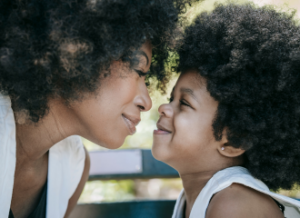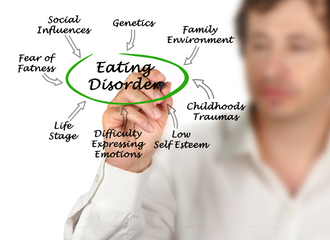Written by: Samantha DeCaro, PsyD
Director of Clinical Outreach and Education
Body image has a big influence on the potential development of an eating disorder. Here are 7 actionable tips to help parents and caregivers promote healthier body relationships.

Although there is no guaranteed way to prevent eating disorders, body dysmorphia, or other mental health diagnoses, parents and caregivers can take steps to reduce the risk, support mental health, and promote a healthier relationship with the body. With that in mind, here are 7 tips to help guide your way.
7 Tips for Promoting Positive Body Image in Kids
#1: Heal Your Relationship with Your Own Body
If you’re a parent or a caregiver struggling with your relationship with your own body, you’re certainly not alone. We live in a culture rife with weight stigma, ageism, and anti-fat biases, so it makes sense that you may have internalized these belief systems.
In addition, body image issues and chronic dieting often trickle down through the generations, so you might be the first in your family ready to confront and break these damaging cycles. It takes a lot of strength and determination to go against intergenerational patterns, but you might feel up for the challenge knowing it will help you, your child, and future generations heal.
Consider enlisting the support of a mental health professional to begin unpacking your own relationship with your body, including the harmful messages you’ve internalized about size, weight, and shape. Becoming aware of your subconscious biases will likely reduce the risk that you will unconsciously project your own insecurities and fears onto your child.
Do not equate weight loss with wellness and do not make jokes about your body as way to cope with your distress. Any jokes about your appearance, no matter how lighthearted, indirectly teach your child which bodies are acceptable and which deserve to be mocked. Treating your body with the kindness and respect it deserves can inspire your child to do the same.
#2: Practice Body Neutrality
Your child is picking up on the body types that get either positive or negative reactions from you, no matter how obvious or how subtle these comments or non-verbal reactions may be. Stop these judgments and take a “body neutral” approach to yourself, your child, and others.
Teach your child that bodies come in all shapes and sizes and bodies aren’t “good” or “bad”. Shift attention away from your child’s appearance and appreciate all the things their body can do.
All bodies are different, but as an example you could remind your child that their arms hug the people they love, their eyes gaze at the stars, or their lungs deliver oxygen to their bodies. If your child shares a critical thought about their own body, teach them how to reframe that thought in more neutral language. Help your child understand that their body is only one small part among the complex layers to their identity. Emphasize the importance of core values, passions, strengths, and inner traits.
By doing so, you’re building your child’s self-esteem and encouraging them to further develop the inner characteristics within themselves.
#3: Foster a Positive Relationship with Exercise
Research suggests that physical activity can be a protective factor against negative body image. Conversely, exercise that focuses on changing the size of the body and sports that idealize a lean aesthetic could potentially have a detrimental effect on body image.
Show your children that movement can be a fun way to play, connect and reduce stress. Teach them that movement should not feel like a punishment and is not needed to earn or burn their food. Despite what the diet and fitness industries say, research tells us that weight is an unreliable measure of health. If you are truly concerned about your child’s physical wellbeing, do not use their weight as a measure for their wellness and enlist the support of a weight inclusive pediatrician or dietician.
Encourage health promoting behaviors by emphasizing the importance of nourishing the body, honoring cues for movement and rest, eating a variety of food, managing stress, developing positive coping strategies, finding community, and utilizing mental health care, if possible.
#4: Help Your Child Develop a Strong Sense of Self
Your child is trying to figure out who they are while the media and various multibillion dollar industries try to convince them that worth is derived from appearance. Do not reinforce these messages. Take time to acknowledge and appreciate your child’s strengths, characteristics, and interests that are not related in any way to weight, shape, or size. Your reminders will help them recognize and develop an appreciation for the many parts of themselves.
Help your child clearly identify their core values, such as kindness, honesty, compassion, and empathy. Teach your child about healthy relationships and encourage them to seek out friendships where they feel fully accepted and safe to be authentic.
Teach your child that it’s ok to say no, set boundaries, and voice their opinions. Support your child’s desire to express themselves through the clothing they wear and remind them that their physical comfort is important, too. Model and embrace vulnerability and imperfection so that your child learns it’s okay to be human.
These small moments with your child can lay the foundation for a self-assured young adult who isn’t easily swayed by society’s unattainable ideals.
#5: Encourage Connection to the Body
Body image is so much more than what we see in the mirror.
Body image can be impacted by how connected and attuned we are to the body’s sensations and experiences. Over time, trusting our body can be difficult when we’re repeatedly taught that we should ignore, suppress, or minimize the messages our body sends.
There are many factors that create disconnection from the body, including following the rigid rules of a diet, wearing uncomfortable clothing to appear smaller, denying yourself your favorite foods, exercising through pain, or telling yourself you shouldn’t feel hungry.
Prompt your child to shift their attention to their bodily sensations and cues to make informed choices about their physical and emotional needs. Validate and encourage your child to tune into these experiences without judgment, identify the words to capture what’s happening, and help them decide what to do next to take care of themselves.
#6: Engage in Meaningful Activities
Many people are surprised to discover that body image issues usually won’t resolve by changing the way the body looks on the outside. The deeper work involves focusing less on the body’s appearance and more on the things that truly matter.
Encourage your child to try new activities or invite them to learn a new skill together. Make a list of activities that cultivate joy, peace, connection, creativity, or inspiration. Check in with your child about how these activities make them feel physically, emotionally, culturally, intellectually, spiritually, or socially. Teach your child the media literacy skills they need to mindfully engage in activities involving social media, movies, and television.
Help them spot and label the harmful messages about bodies in the media and show them ways to challenge those messages. Highlight when your child’s behaviors align with their core values to help them recognize the moments when their actions are in alignment with what truly matters to them.
#7: Reach Out for Support
You don’t have to do body image work alone. If you are fortunate to access mental health services, consider reaching out to a therapist, joining a support group, and/or seeking the services of registered dietician for you and/or your child.
Show your child that mental health is just as important as physical health and instill that the two are intertwined. Some things in life we do independently, but healthy functioning includes knowing when support, help, guidance, or connection is needed from others. Take time to make a list of the supportive people in your life and encourage your child to do the same. Remind your child about this list when they’re feeling the need to connect.
Conclusion
Unfortunately, there is no guaranteed way to prevent your child from developing body image issues, body dysmorphic disorder or a clinical eating disorder, however there are many ways to support their mental health and create a strong foundation of protective factors.
The most challenging part of this work often includes healing your own body image concerns and gradually unlearning the harmful beliefs passed down to you. Breaking cycles isn’t easy work, but it’s a priceless gift to your child.
The good news is that you can make impactful changes today by taking a neutral approach to weight, prompting your child to connect with their body, encouraging your child to engage in meaningful activities, re-defining the purpose of exercise, fostering an authentic identity, and enlisting the support of others. Children watch and learn, so never underestimate the power a parent or caregiver has by simply modeling these changes.



